The 35th Marathon des Sables 2021 has ended. Normally taking place in late March to mid April, the 35th edition was staged in the Sahara desert in October. The reason for this was of course the COVID-19 pandemic which had seen the race postponed three times since the original due date in April 2020. With hot temperatures and a drop-out rate of 47%, it will go to the history as one of the all-time toughest editions of MDS.
Some competitors have voiced concerns over what they experienced this year. The Marathon des Sables issued a statement commenting on the high drop out rate and mentioning multiple possible causes: unusually high temperatures (even for this time of year), high humidity and no wind; gastrointestinal problems amongst runners and staff; participants’ preparations possibly having suffered as a result of the pandemic; and finally morale affected due to a participant sadly passing away at stage 2.
Sharing my perspective from the sidelines
I watched from the sidelines this year, like many friends and family members. In this article I will discuss some questions and try to put a few things into context. I hope that this might be useful for some who didn’t finish, for some who did, and also for future competitors and their families who may now be worried about a hard race.
This is my own opinion. Someone might say I wasn’t there so what do I know? It’s correct I wasn’t there. I have however completed, as well as attempted but not finished, races that have been well and truly gruesome. I have run in the Sahara six times, of which four in the MDS, I have run in several other deserts. I have run in heat and high humidity. I have coached people for the MDS since 2015 with high success rate. I coached people for this edition who managed well and finished. I put forward my perspective based on this and I discuss the following questions:
- Does the death of a competitor mean the race was unsafe?
- What does a drop-out rate of 47% mean compared to other challenging ultra-marathons?
- What expectations have entrants realistically had of the Marathon des Sables?
- What responsibility should be put on entrants into a self-sufficient race in extreme conditions?
- Should the race organisation have been more prepared?
- What can future competitors learn from this?
Does the death of a competitor mean the race was unsafe?
A runner suffered a cardiac arrest and passed away on day 2 of the race. Firstly let me say that it is a tragedy when someone dies in a race and my sincere condolences go out to this competitor’s family.
It can be easy to come to the conclusion that because a runner dies it proves the race was unsafe. It does not.
Unfortunately runners do die in races. Runners die in normal road races like marathons and half marathons. In late August a runner suffered a fatal accident in the technical TDS which is one of the UTMB races.
Everyone who puts themselves on the start line of a running event can suffer injury or death. It can arise from unknown underlying medical conditions, there can be fatal accidents, and the weather can play a part. At what point should the race be held accountable if a runner dies who voluntarily put themselves on the start line knowing the rules and the risks? I do not have a clear-cut answer to this question, but I believe the race should be held accountable when we have events like earlier this year in China when 21 runners froze to death in a preventable tragedy.
I think the race should be held accountable if there was neglect in providing reasonable safety precautions. For example I would expect a responsible race director who stages a race in remote wilderness to have gps tracking on all participants, to have logistics for emergency rescue in place, to demand that everyone has the required equipment and for that equipment to be suitable for the challenge. I would expect a well-marked course unless it was explicitly a self-navigating event. I would expect enough water provided. I would expect that if life-threatening weather was forecast, the race be cancelled. I would expect a sweeper on the course. In addition, I think it is necessary to have medical staff in a race.
I have been in – and observed – races where some of the above was missing and I have been worried about that. MDS is in my experience not one of those races. Few races have the safety infrastructure in place that MDS has. Helicopters, frequent check points, 4x4s, GPS trackers with emergency button, a sizeable medical team even considering the amount of runners. And probably more that nobody ever sees. That is why I usually say it is a safe race for what it is. Participants are also required to undergo a medical check to take part. What they are not required to do however, is to prove their previous credentials of running ultramarathons, nor of running races in extreme heat. It is the responsibility of the participant to understand their own state of health and what risk it could pose for them as an individual to take part.
This year clearly the organisation was overwhelmed by the amount of people suffering issues but more on this below.
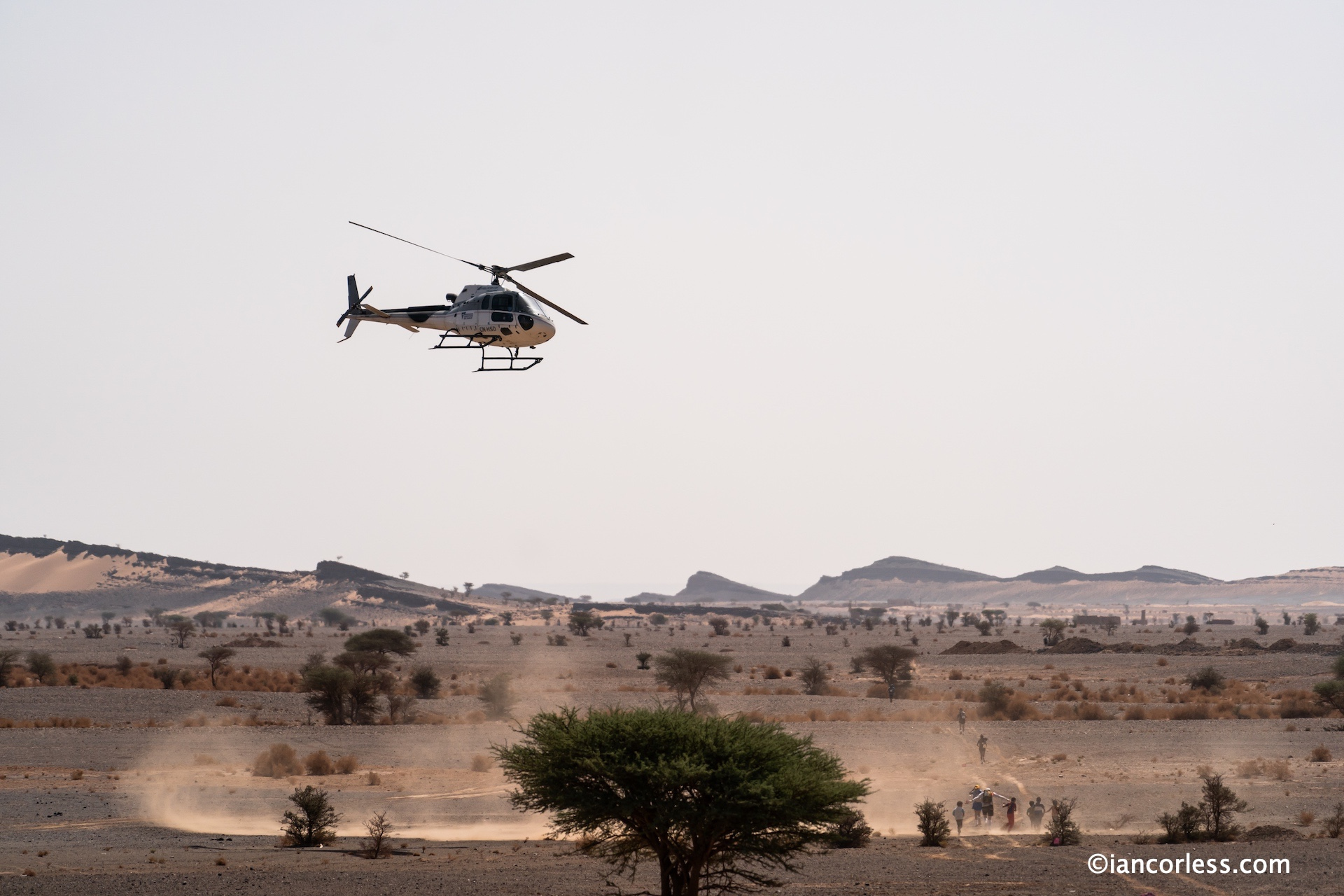
What does a drop-out rate of 47% mean compared to other challenging ultra-marathons?
Marathon des Sables carries the tagline “the toughest footrace on earth”. There is no doubt that it’s a tough race. Running in the desert is always hard, and the self-sufficiency and simple camp life introduces a challenge not seen in single stage ultras. You have to manage yourself throughout the week including recovery, sleep, nutrition, hygiene, foot care and so on. Even with these challenges the Marathon des Sables has been a very achievable race historically.
I have done it four times since 2012 and I believe that under normal circumstances most people with normal fitness, who have done the right preparations and are not afraid to dig deep when it gets tough, can complete it. Completion rates vary but are normally over 90%. The last edition in 2019 had only 40 withdrawals corresponding to 5%. It was a short edition with fast races times.
Some other editions of MDS have been more challenging:
2006 had a drop out rate of 20%. 731 runners started and 585 finished. According to the race website there was a dry wind and very high humidity. The long stage was shortened by 10km due to the conditions.
In 2009 the desert flooded, resulting in the longest long stage on record with 92km, but the shortest MDS course overall with 202km. The course had to be improvised.
2016 was another challenging year and with 257km the longest edition yet. Stage 1 included with 15km of dunes. When a sandstorm hit, the navigational challenges became overwhelming for many who were not prepared for the conditions carrying their full backpack. The drop out rate for this edition was 13% with 145 withdrawals and 973 finishers.
The 2021 edition has seen a drop-out rate of 47%. According to the live tracking, 319 competitors withdrew out of 672 starters.
So what about other races?
How do other races compare to the MDS?
Drop-out rates vary enormously. Many races, like the MDS and many similar other races who have adopted the same format, hover around 5-15%. I would say this is the drop-out rate for an achievable race that people of varying ability and mental toughness can take on with adequate preparations.
Some races on the other hand typically have no finishers at all, like the legendary Barkley Marathons. This race has nothing in common with the MDS but if we choose to call something “extreme” or “toughest” let’s just look at what extreme can really mean.
Other races are very tough, but entrants have to qualify by doing other races first. This raises the quality of the field that stands on the start line, but the number of withdrawals can still be high. One such race is Spartathlon (also always hot) with a 2021 drop-out rate of 40% and a 2019 drop-out rate of 48%.
Another race is the popular UTMB. It’s not at all similar to MDS but it’s also a big race and many finishers of the MDS want to do it, hence including it here. The UTMB normally has 30-40% withdrawals and that is with demanding pre-qualifications.
The Dragons Back stage race in Wales (similar format to MDS but not self-sufficient and taking place in the mountains) had a 76% drop-out rate in 2021 edition. There are no prerequisites for this race.
In this context 47% is still quite high but for a challenging race in an extreme environment, with no vetting of competitors’ prior experience, it’s by no means outrageous at all.
Of course it is a very simplified view to look only at the drop-out or completion rate of a race to judge how challenging it is. I am not trying to make a full comparison at all, I just want to just put the number into context.
What expectations have entrants realistically had of the Marathon des Sables?
With the above being said, the difficulty of a race as experienced historically, of course creates expectations. Statistics and stories create a narrative and an image for prospective competitors. Hopeful entrants know that the chance of completing is high. They have seen that only 5-10% have to withdraw and they can take some comfort in that. Maybe if the drop-out rate was consistently at 40-50% and if temperatures were consistently a few degrees higher than the average, they wouldn’t even contemplate it.
MDS is a contradiction. It’s “the toughest footrace on earth” yet typically achievable and well within reach for those who dream of completing a gruelling ultra-marathon. Perhaps that is part of the appeal.
This year’s edition was a more accurate representation of the tagline, but that is not what people signed up for. It wasn’t part of the narrative. They signed up for something they thought would be tough but not quite THAT tough. I believe it generates completely different expectations for the participants if they believe they have a 90% chance of finishing than if they believe the chance is 50%. Understandably it’s disappointing for those who had to withdraw.
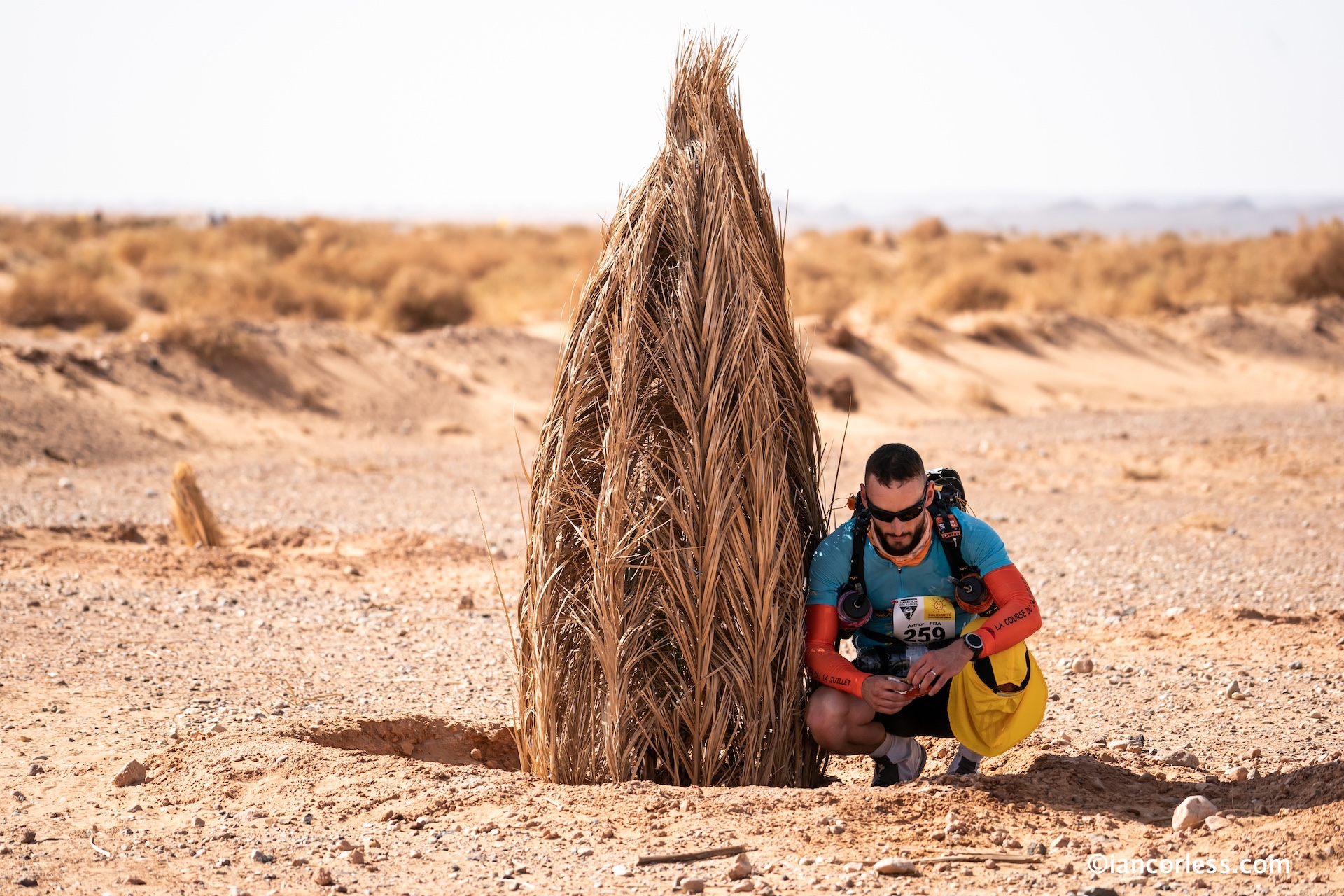
What responsibility should be put on entrants into a self-sufficient race in extreme conditions?
One important question that this year’s edition raises for me is: at what point does the competitor’s responsibility for their own health and race management end, and at what point does the race become responsible for their care? Or put another way, is it reasonable to demand of competitors that they have full understanding of what they are embarking on including the risks, and how to prepare for, and safely execute, the race? I believe it absolutely is reasonable.
Self-sufficiency in the Marathon des Sables
The Marathon des Sables is marketed as a self-sufficient race. This means that participants carry their clothing, sleeping system, other personal belongings, and all their food. They get water which is rationed. Extra water is handed out if conditions demand it, such as this year. If you need additional water over and above that, you get a time penalty. Participants are also provided salt tablets. This is different from many other races which demand that competitors take their own electrolytes. This means other races might have less control over what the runners ingest.
There is a well-equipped mobile field hospital so it’s actually not required to carry any medical supplies. This is often mandatory in other similar races which do not have the medical capacity of the MDS. From this perspective the race is not strictly self-sufficient because you can get help if you need it. I personally believe this is good even though I always try to be self-sufficient when it comes to looking after my feet and taping blisters. The ethos of the race is the self-sufficiency. Requesting medical support should not be the first option, it should be what you turn to in an emergency.
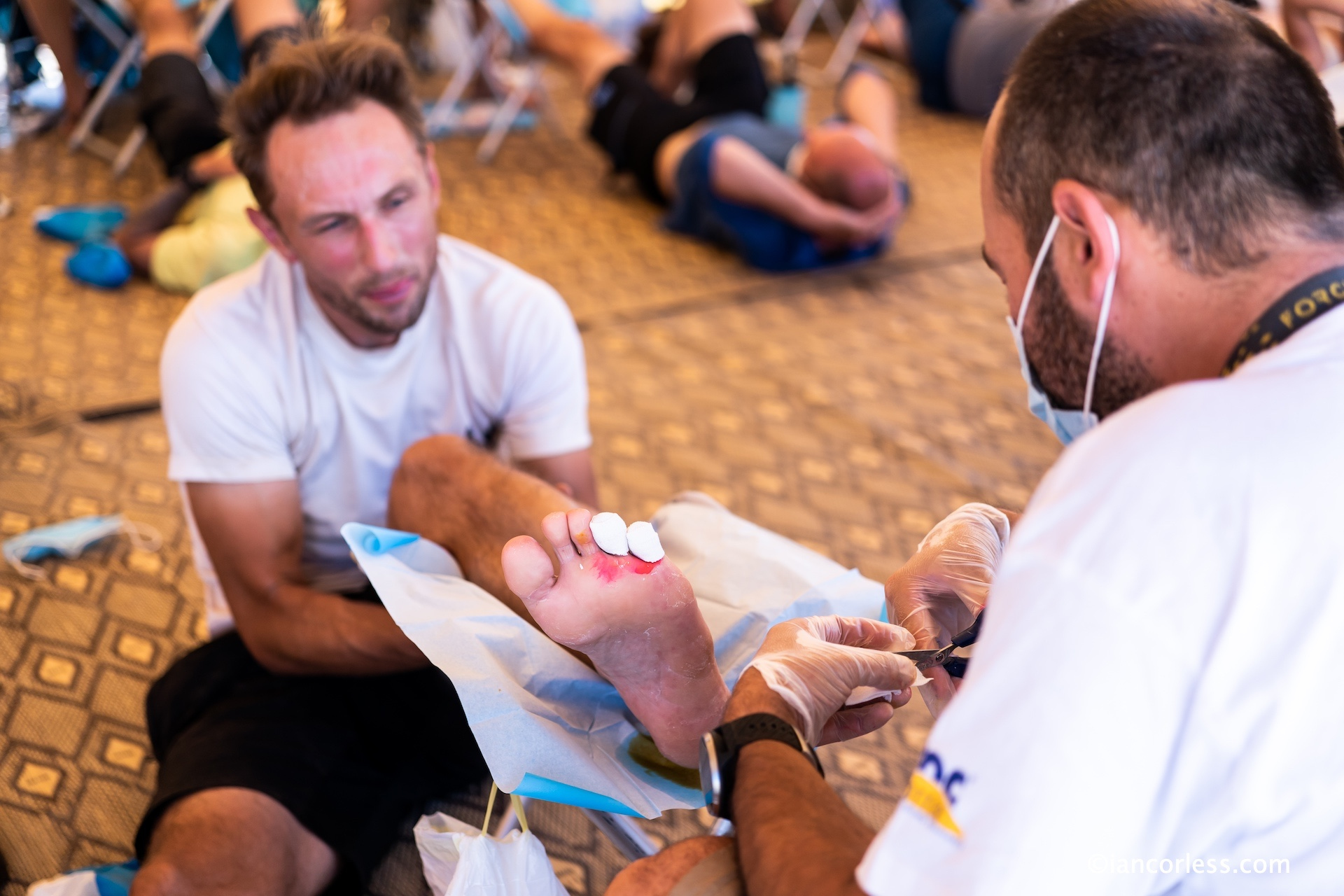
How should runners prepare for this self-sufficiency?
I believe that in a “normal” year of the MDS, that is with normal temperatures and kind weather conditions, it is possible to wing it a bit and still make it. Not being totally complacent of course, but if everything hasn’t been prepared optimally you can still make it. In a year like 2021 clearly this was much more difficult and things that you would normally get away with you wouldn’t get away with this year.
So what do I think a competitor in the MDS (or another similar race) should be responsible for? What is well within the runner’s control and a reasonable expectation? Here are a few thoughts:
- Understanding the weather conditions and acclimatise accordingly. Researching weather conditions shows that the temperatures in early October can be expected to be similar or slightly higher than those of early April. It means that although temperatures can vary greatly one should not expect a cool race. Acclimatising to the heat is therefore critical. I cannot emphasise it enough, and I believe it is a resonable responsibility to put on a runner in their preparations whether the edition takes place in April or October.
- Knowing how the body reacts in heat. This I feel is important and related to point 1 above. It should not be the first encounter with extreme heat when a runner arrives at MDS. You should have developed an idea of how much you sweat per hour when exercising in that heat, ideally have tried sodium or electrolyte supplements, understand how your sweat rate corresponds to the water you get given and the time you can expect to be out on the course.
- Knowing how to navigate in the dunes. Dunes always feature in the MDS and a compass is mandatory for a reason. It takes one YouTube video to learn how to take and follow a bearing without a map and this is a basic skill which can make or break your race.
- Having done sufficient and specific training. It sounds extremely basic and most people are very serious about this, but some aren’t. They think they can just turn up. Especially those who have done it in the past and believe they are still a fitter version of themselves than they actually are.
- Having not over trained. Many people actually believe that more is always better and so they arrive at the start line with an empty tank or one that is not full, and they may not even realise it. I see it every year and I observed it this year. People do ultramarathons, marathons, or very long training runs very close to the start of MDS. Don’t complain you had to withdraw because of low energy if you didn’t save your fuel for the main event in the first place!
- Testing all kit and food in training. Know how it feels running with a full backpack. Optimise the weight of it. Research your kit and food. Understand how much food you need, what kit you need. How can you make it lighter? Every gram matters and if you pack “comfort items” that takes your backpack to 3 kilos extra you might be ok with that in a normal year. When temperatures soar well above average you will regret it.
- Being disciplined with race pace. Linked to point 1 and 2 above, this is an extremely common problem: setting out too fast. The adrenaline runs high, everyone is pumped, and set off too fast. The only way you can keep core temperature below dangerous levels in MDS is to hydrate and manage your pace. You can stop and find shade but there is not much of it. The margins can be tiny. Go too fast and you are toast. I have seen this happen and know it happened this year. Unfortunately, some of the people who get seriously ill because of this don’t always make the connection themselves. In a normal year maybe a night on IV will get you back on track, in a hot year it might be a costly mistake which means the race is over or worse, a threat to life.
- Managing hygiene in the race. Evident perhaps, especially after the pandemic we’ve all experienced. I mean who goes anywhere without hand sanitiser now? It’s of course the case that any gastrointestinal problems, fever or illness is extremely difficult to combine with the heat. Participants should take every possible measure to avoid the spreading of bugs.
- Reading the race rules. The Marathon des Sables is actually a race that has very detailed race rules and they are mostly very clear. Yet, people fail to read them and rely on third parties. It blows my mind every time. Questions like “how much food do I need”, “how much water do we get”, “do I need this or that item?”. It’s stated in the rules and it’s the first point of call because people spread misinformation online.
- Understanding and taking responsibility for your own health. Book an appointment with your GP. Tell them what you’re doing. Ask for blood tests and an ECG well ahead of time to rule out any problems you might not know about. Talk through any family history of illness or any condition you might have which could pose a risk. Consider an exercise ECG. Consider lifestyle changes if that seems necessary.
- Being realistic about the risk of the event you are doing. Are you prepared to take the risk? I think everyone has a responsibility to understand what they are actually doing and what could go wrong. It might be an organised event but you are still going to an extreme environment, taking part in a self-sufficient race. There is a lifeline in the form of a medical team. They want to help you finish but they are not there to hold your hand. They are there in the event of emergency.
Am I suggesting that many competitors this year had failed in their preparations and race management? Absolutely not. I know of people who could have done nothing more, who had prepared meticulously, and they still had to take the difficult decision to stop. I feel their pain and disappointment. I also however know of people who knowingly or not neglected one or several of the points above. That will always happen, but my point is just that in a normal year the margins for error are greater than they were this year.
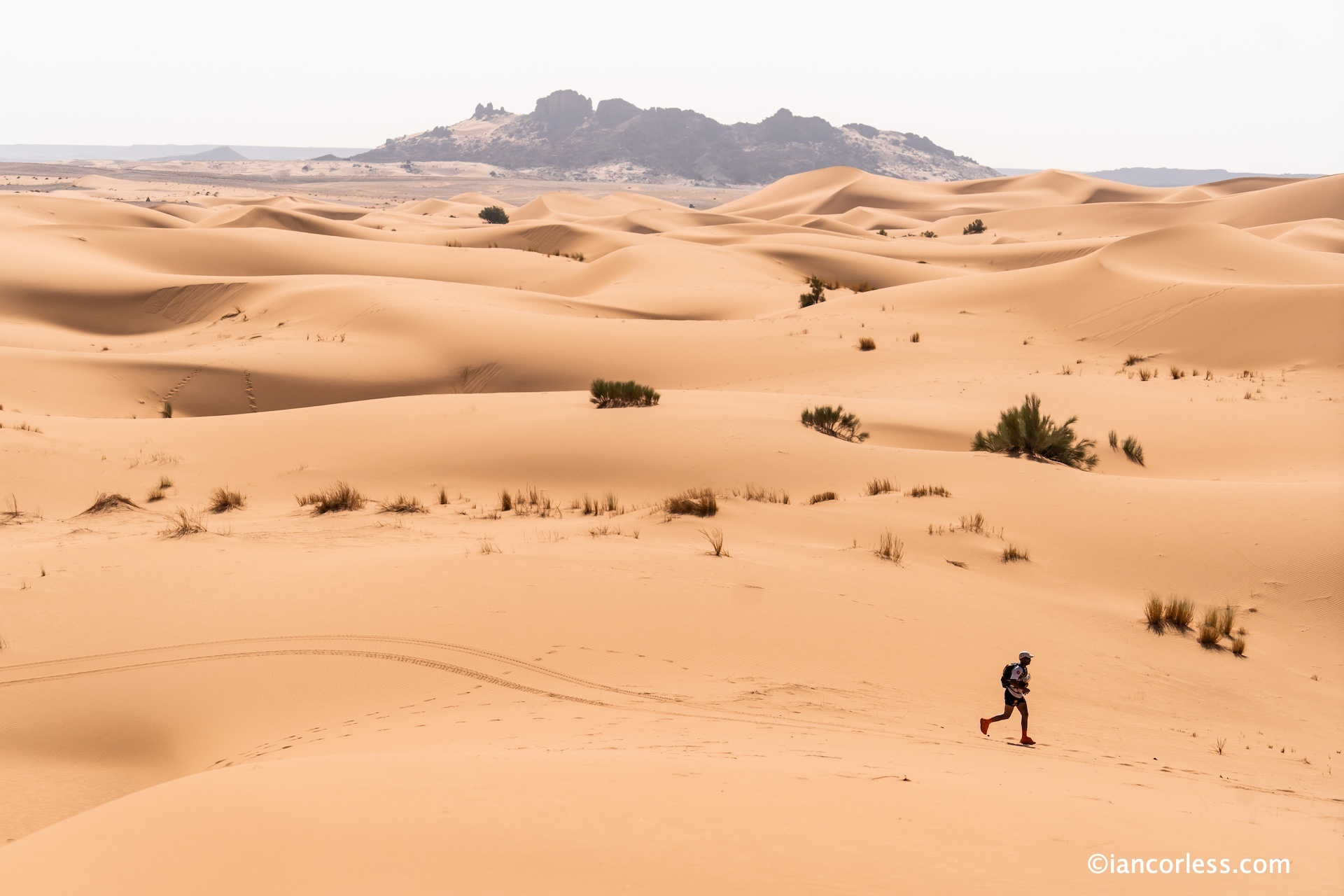
Should the race organisation have been more prepared?
Apparently it was unusually hot for the time of year. It seems to me it would have been possible to get indications of this ahead of the race and make adjustments. Maybe that happened but it wasn’t enough? Maybe it didn’t happen and if so why not? Did the organisation properly research weather conditions ahead of time and whether deviations could be different from April, for example hotter? Did they follow the weather forecast in the weeks before to adjust to conditions?
Start times could have been even earlier for the stages. When I ran in Oman and Costa Rica we started as soon as the sun started rising because of the heat. The long stage could perhaps have been shortened within the constraints of still arriving at the same finish. This possibility was perhaps evaluated. Did the organisation actually have the agility and resources to make such swift adaptations or was this potentially lacking?
That being said there have been hot editions before without the consequences it had this year so was it realistic to expect such adjustments from the get go?
To be prepared for a sudden spike in drop-outs from 50-ish to 300+, most of which happened in the first three stages (Stage 1- 41, Stage 2 – 86, Stage 3 – 107), is probably not realistic. No doubt logistics were scaled based on past experience and it was in addition a smaller field than we have seen the past few years. How many scenarios should you plan for, and at what point do you have to increase the price for an event that is already costly to enter, in order to have every “what-if” event covered and hand-hold participants from start to finish?
When to cancel a race?
One can contemplate if there should actually be a maximum temperature for when the MDS potentially gets cancelled. What is too hot though? What is really not safe, but then for whom? Should some competitors who are well acclimatised be allowed to race and others not? Or should the well prepared runners be penalised because others are less prepared, have poor race management, or just simply do not deal well with the heat? Should the cut-offs be more strict to filter out people earlier to avoid so many staying so long in the heat? But then will that just further encourage competitive runners to accidentally run beyond their ability in such heat? Or should there be a pre-qualification?
Should water rations have been increased?
Everybody needs different amounts of water and for various reasons. Some runners have said they struggled with the water allowance this year not being enough (I believe some extra water was handed out but I do not know how much and how many people actually needed it). If there is a time penalty for taking extra water over and above the allowance, how does that impact on a runner’s behaviour and self-management in the race? Will they deny themselves water they might need because they want to avoid the time penalty? At what point does this become unsafe?
At the same time water is a limited resource. I have been in a desert race where water was not limited and it’s not ideal either because some people misuse that. Is there a middle ground though where more water can be allowed without penalty by increasing the ration if conditions call for it? Could logistics allow for that to be implemented?
Acclimation to heat and a diligent food and electrolyte intake impacts hydration so there would have been big individual differences here which means there is no clear-cut answer as to how much water should be provided. Under normal conditions the water allowance is ample for most people.
Was it just the heat?
Some entrants and staff suffered gastrointestinal problems with vomiting and diarrhoea. It’s also not the first time in the history of the race, but of course an unfortunate combination with higher than average temperatures. Being dehydrated in extreme heat is an almost impossible, and indeed dangerous, undertaking.
What was the cause of these problems? It’s easy to jump to the conclusion that there was a viral or bacterial infection, which some participants have suggested. Some blaming the race for a bug spreading. However, heat related illness also has these symptoms and we know it was hot. It was also hot pre-race for the administrative checks and competitors were exposed to the sun when queuing up with their race gear.
If it was indeed an infection where did it come from? It could have been brought to camp by anybody and not necessarily the fault of the race as such. If it was food poisoning of some sort from the catering pre-race this is of course a disaster and one that should not be allowed to happen.
And what about the impact of the pandemic which has seen people in isolation, practising social distancing and avoiding travelling, restaurants and bars. Has that possibly impacted our general resistance to infection? Or, have those who have had COVID suffered any long term effects which perhaps showed up under extreme physical stress?
What can future competitors learn from MDS 2021?
Future competitors who consider the Marathon des Sables might have been worried by stories from this year’s race or from the statistics. We should however remember that the MDS has extensive experience as an organisation. The “perfect storm” of unfortunate events will hopefully help the race become even better.
However, the aspiring competitor should not be complacent. You cannot leave anything to chance. Prepare meticulously. Turn every stone. Do everything you can so that at least if external circumstances hit that are not within your control, you know that you did everything you could.
Also, going back to the drop-out rate. 47% didn’t finish. 53% did finish. They did something right. It was an exceptionally difficult year and 53% still finished. The difficulty of this year’s race is on par with other challenging ultra marathons. If you aspire to do MDS and then any of those other races I mentioned above, then you really should not be put off by this year’s result.
Final thoughts
It was a one-off to stage the race in early October and I believe this was not a success. I would expect that this doesn’t happen again once the normal schedule is back on track for April 2022.
I would also expect a thorough evaluation by the organisation of what went wrong and what checks can be put in place to avoid this happening again. Not because I believe that a drop-out rate of 47% in an ultra-marathon is terrible as such, but it is unnecessary and it deviates significantly from the expected difficulty of the race.
What do runners want?
One problem of course is that some people are never satisfied. This year it was apparently too hot, but what if the race was cancelled altogether with no refund due to too extreme weather conditions? Then that would have caused a storm of complaints instead.
People want to challenge themselves and test their limits in extreme events. At the same time they want to do that within the safety of some comfort zone that nature doesn’t care about. They want to do the toughest foot race on earth but for it to be risk free and cozy. It’s an impossible demand. There will always be a degree of uncertainty and it is part of the package. Likely it will be hot but there has been flooding, hail storms, relentless sand storms, snow, and really cold nights at the time of the MDS too.
Back to normal?
I love the fact that the Marathon des Sables has been an inclusive race which is achievable for those who are not elite, and also which is achievable for many who otherwise would not be able to qualify for some other races, nor get through them. I want to see the withdrawal rate back to normal and I am confident that this edition was an unfortunate one-off, with many factors conspiring to a less desired outcome.
Hopefully it will help the organisation elevate the race to new levels, and also help competitors to not leave anything to chance. It’s unfortunate for those who couldn’t finish this time but there is always something to learn from every experience we have.
Learn from the experience
The hardest part is looking at what we could have done differently ourselves. It is always easier to blame the circumstances or the organisation. And maybe sometimes there is nothing more we could have done. Then we need to make peace with that fact. Accept that we did what we could.
If there is no weather-window to climb Everest you can’t blame the expedition you signed up with. You similarly can’t blame the MDS for it being hot in the Sahara. Those are very real and likely risks you have to accept. And just like sometimes you have to turn away 200m from an 8000m peak, sometimes you have to know when it’s time to quit a race. It’s always disappointing but it’s not a failure. It’s another experience that will make you wiser for the next one.
I celebrate everyone who had the courage to put themselves on the start line. You should be proud regardless. To those who finished, you really deserved the medal. It was probably the toughest edition of the MDS yet.
Run well and enjoy the journey!
This post was first published on October 12th 2021. Updated 13th Oct to include paragraph on the pandemic’s possible effects on immunity. Updated 15th Oct to include section on rationing of water in the MDS, plus updated section on how other races compare in order to better clarify rationale for including those races in the article.
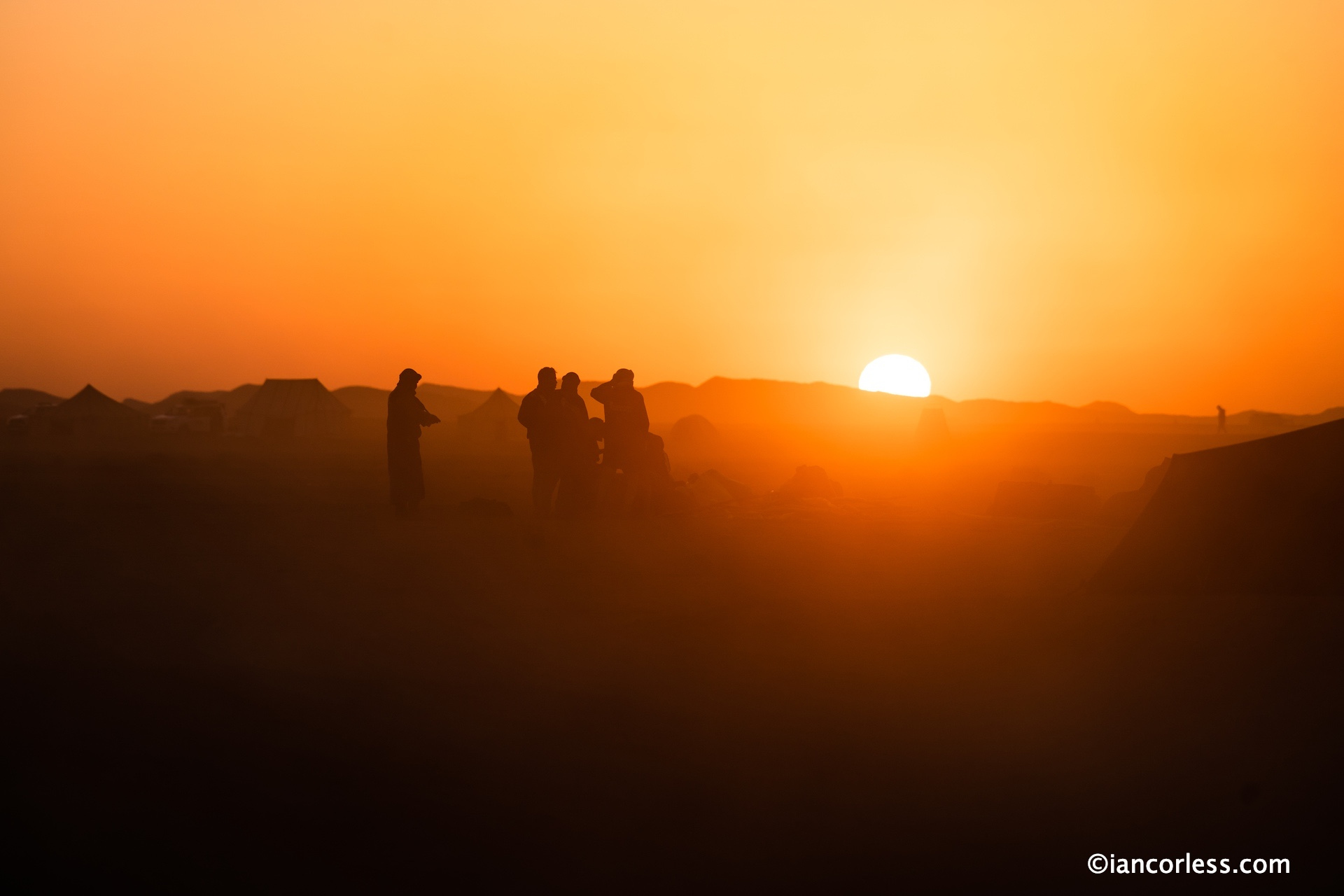
For MDS bespoke coaching click here.
For trail running camps in Gran Canaria, click here.
